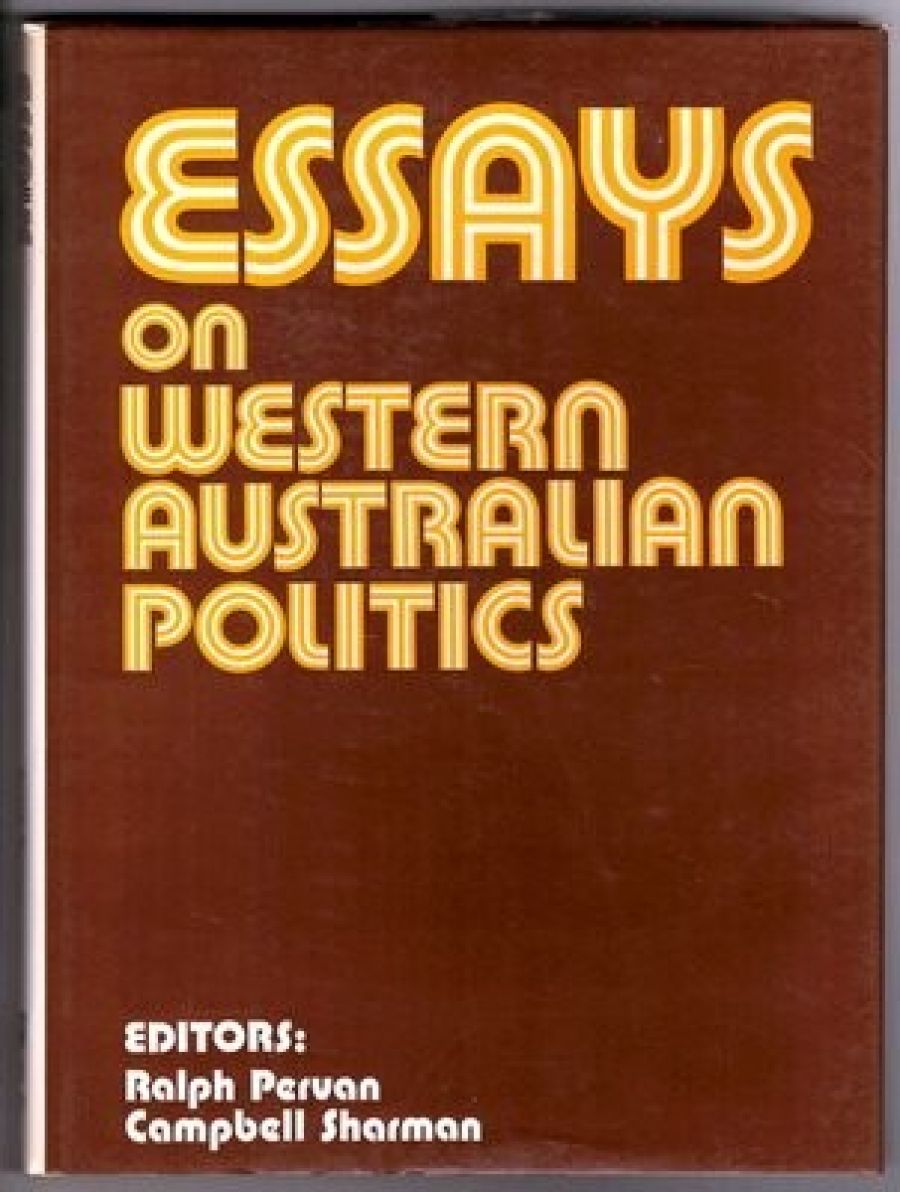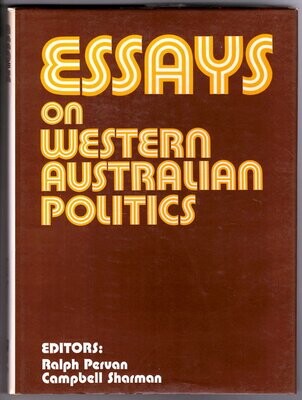
- Free Article: No
- Contents Category: Politics
- Review Article: Yes
- Article Title: The Sound of Marching Feet
- Online Only: No
- Custom Highlight Text:
This is an interesting and important book dealing with Western Australian politics in general but it also manages in depth treatment of various aspects of the political process. The book is divided into two parts: the first part deals with government, which includes the federal-state relationship, the parliamentary system. electoral politics, public administration, the role of the executive and the place of local government in Western Australia. The second part of this well-conceived book deals with party politics and the role, nature, organization and ideologies of the three major political parties. The occasion for publication was the 150th anniversary of the founding of Western Australia and this constitutes a scholarly contribution to mark the occasion. It is easy to agree with Sir Charles Court, the Western Australian Premier, when he writes in his foreword that ‘the collection is seen as a worthwhile contribution to the scholarly heritage of the State’.
- Book 1 Title: Essays on Western Australian Politics
- Book 1 Biblio: U. of W.A. Press, $15.00 pb, 237 pp
- Book 1 Cover Small (400 x 600):

- Book 1 Cover (800 x 1200):

The coverage given in the book to Western Australian politics is not comprehensive but as the editors point out in their introduction the general reader and the student of politics should derive a multiplicity of facts on the political life and history of Western Australia. The importance of this book, however, lies in its description, treatment and analysis of the political process in a state whose contribution to the federation is today immense. Western Australia earns 25 per cent of the country’s gross national product – and will in the years that lie ahead contribute even more than that when the development of the state’s oil, natural gas and mineral riches gets off the ground. The North West Shelf gas fields, below the azure waters off the lengthy and magnificent Western Australian coast, are the equivalent of a giant oil field in today’s energy-dependent world. This prestigious project is the centre-piece in a staggering collection of resource schemes which the state is seeking to develop through outside investments from one source or another.
The figures are impressive: Woodside. the principal partner in the North West Shelf, will be asking the Japanese for $20 a second for 20 years when that particular project gets going.
It is clear from all this that the politics of development and resource allocation will pre-determine the nature of politics in W.A. in general and of the relationship with the federal government in particular. Indeed, fascinating as the politics and history of W.A. are, the future political struggles at both the state and federal levels will prove infinitely more complex and important as the relative and absolute political weight of state government grows over the remainder of this century. The proper context of W.A. politics lies in its importance to the rest of Australia as the perception of its economic and commercial resources grow in the minds of the Canberra-centred political elites.
The riches of W.A. could excite a secessionist mood, which some say is just beneath the surface. As Professor Reid observes in his essay, ‘the people of Western Australia have not been consistently enthusiastic or even acquiescent about their membership of the federation’. The inter-governmental conflict, subsumed by the expression ‘New Federalism’, as seen from Perth, carries with it the seeds of increasing conflict with the centrist tendencies of the Federal government over a whole range of issues and policies. I rather fear that Professor Reid may well have underestimated the potential for conflict over the proper boundaries between state and federal politics in regard to policy-making and execution.
Both Bruce Okely and Jeremy Buxton contribute to our grasp of the evolution of Western Australia’s parliamentary system and its electoral politics.
Martyn Forrest attempts a most ambitious approach and offers no less than six methods of analysis of public administration in a bid to gain an insight to understanding the executive in Western Australia.
The essay on local government is less theoretical and provides a sound history of the subject and comes to the conclusion that local government ‘may fall prey to the compelling need felt by larger governments to be centralist initiators and coordinators of policy’.
The last three contributions in part two on the political parties are of considerable value and interest because of the changing nature of political behavior and the growing complexities of pluralist politics. They manage to convey a distinct impression of the peculiar nature of Western Australian politics which sheds further light upon the evolving nature of politics throughout the whole of Australia. Ralph Pervan and Douglas Mitchell have much to say that is original on the ALP; Lenore Layman presents a good synoptic view of the Country Party and lastly, David Black, makes a solid and interesting contribution to our body of knowledge of the Liberal Party.
This book is strongly recommended for those with more than an academic interest in politics and should be compulsory reading for aspiring politicians.


Comments powered by CComment